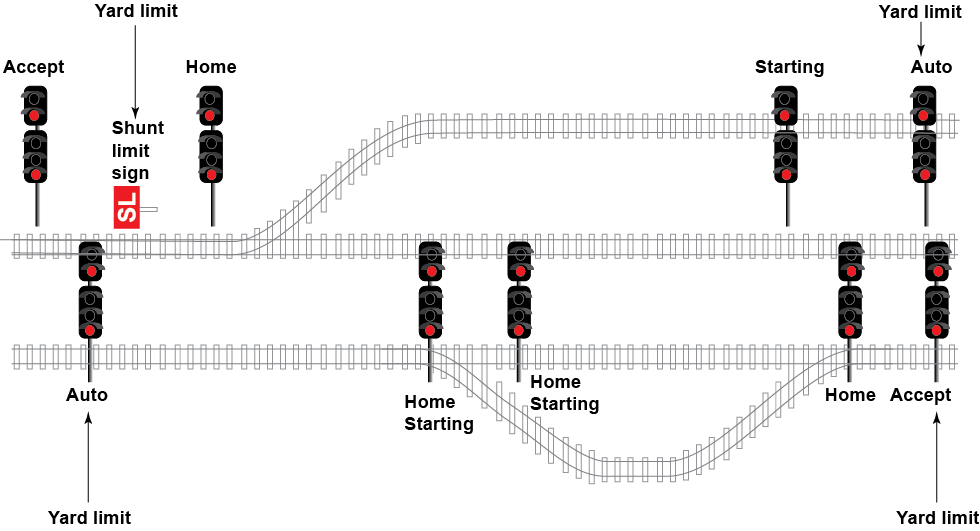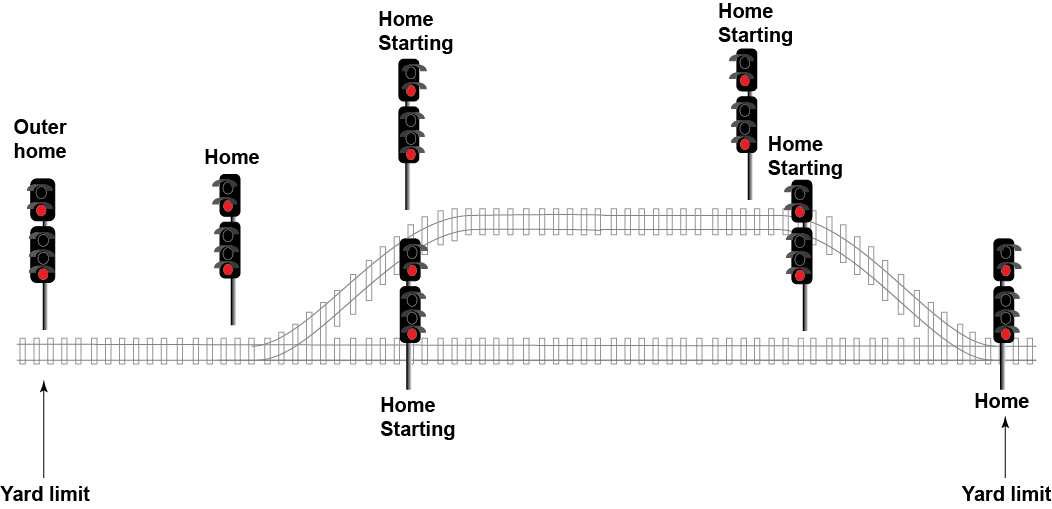Description
This document describes the requirements for safe movement of rail traffic within yards.
Not what you are looking for? See more NTR Rules
Purpose
To prescribe the rules for safe movement of rail traffic within yards in the Network.
Principle
Signallers must plan and agree about movements from one Signaller’s area of responsibility into another Signaller’s area.
If fixed signals are not available, Signallers:
- may give spoken authority for movements within yard limits
- must not authorise unsignalled movements to proceed beyond yard limits.
Yard limits
Depending on their availability at a location, signs or signals determine arrival-end and departure-end yard limits.
In order of priority, a yard limit is determined by a:
- YARD LIMIT sign, or
- SHUNT LIMIT sign, or
- specified signal.
Rail Vehicle Detection territory
Unidirectional double-line
Yard limits in unidirectional double-line Rail Vehicle Detection (RVD) territory are determined by, in order of priority:
| End | Limit |
|---|---|
| Arrival | YARD LIMIT sign |
| SHUNT LIMIT sign | |
| First controlled signal | |
| Departure | END YARD LIMIT sign |
| First automatic signal beyond a starting or home/starting signal | |
| Starting or home/starting signal |
Bidirectional double-line
Yard limits in bidirectional double-line RVD territory are determined by:
| End | Limit |
|---|---|
| Arrival | YARD LIMIT sign |
| Departure | END YARD LIMIT sign |
Bidirectional single-line
Yard limits in bidirectional single-line RVD territory are determined by, in order of priority:
| End | Limit |
|---|---|
| Arrival | YARD LIMIT sign |
| SHUNT LIMIT sign | |
| Outer home signal | |
| Home signal | |
| Departure | END YARD LIMIT sign |
| SHUNT LIMIT sign | |
| Outer home signal for the opposing direction | |
| Home signal for the opposing direction |
Yard working
Running lines
Rail traffic movements on running lines within yard limits must be authorised by Signallers at attended locations.
Signallers must make sure that they do not authorise conflicting movements.
If available, fixed signals must be used to authorise movements.
Signals at stop must be passed only in accordance with NSG 608 Passing signals at STOP.
Unsignalled movements within yard limits must not exceed 25km/h.
For unsignalled movements in a tunnel, the Driver or Track Vehicle Operator must:
- not exceed 10km/h
- stop at platforms and report arrival to the Signaller
- get the Signaller’s authority to proceed.
Shunting yards and sidings
Movements within shunting yards and sidings must be directed by the responsible Qualified Workers.
Qualified Workers directing movements must make sure that they do not authorise conflicting movements.
Shunting movements must be made in accordance with NTR 420 Shunting and marshalling and NTR 424 Propelling rail traffic.
RVD territory
Unsignalled opposing movement
Before authorising an unsignalled movement that opposes other rail traffic, the Signaller must make sure that at least one unoccupied block is maintained between the movements.
Until one of the approaching trains or track vehicles is brought to a stand, the block between the opposing movements must remain unoccupied.
Bidirectional lines
Before authorising an unsignalled movement beyond a starting or a home/starting signal on a bidirectional line, the Signaller must:
- tell the Network Controller about the movement
- compile an NRF 012 Unsignalled movement checklist
- tell the Driver or Track Vehicle Operator for the unsignalled movement not to proceed beyond the relevant yard limit.
Consolidated yards
Before authorising an unsignalled movement into or through one or more blocks protected by automatic signals in a consolidated yard, the Signaller must:
- tell the Network Controller about the movement
- compile an NRF 012 Unsignalled movement checklist
- if there is an affected locally-controlled interlocking machine, tell the Qualified Worker in charge about the movement
- make sure that the route is set correctly, and that no conflicting movements will be authorised.

